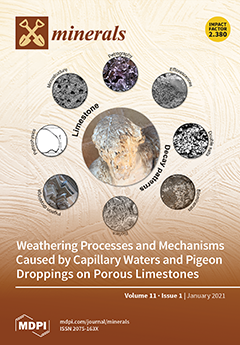A new mineral, dioskouriite, CaCu
4Cl
6(OH)
4∙4H
2O, represented by two polytypes, monoclinic (2
M) and orthorhombic (2
O), which occur together, was found in moderately hot zones of two active fumaroles, Glavnaya Tenoritovaya and Arsenatnaya, at the Second scoria cone of the Northern Breakthrough of the Great Tolbachik Fissure Eruption, Tolbachik volcano, Kamchatka, Russia. Dioskouriite seems to be a product of the interactions involving high-temperature sublimate minerals, fumarolic gas and atmospheric water vapor at temperatures not higher than 150 °C. It is associated with avdoninite, belloite, chlorothionite, eriochalcite, sylvite, halite, carnallite, mitscherlichite, chrysothallite, sanguite, romanorlovite, feodosiyite, mellizinkalite, flinteite, kainite, gypsum, sellaite and earlier hematite, tenorite and chalcocyanite in Glavnaya Tenoritovaya and with avdoninite and earlier hematite, tenorite, fluorophlogopite, diopside, clinoenstatite, sanidine, halite, aphthitalite-group sulfates, anhydrite, pseudobrookite, powellite and baryte in Arsenatnaya. Dioskouriite forms tabular, lamellar or flattened prismatic, typically sword-like crystals up to 0.01 mm × 0.04 mm × 0.1 mm combined in groups or crusts up to 1 × 2 mm
2 in area. The mineral is transparent, bright green with vitreous luster. It is brittle; cleavage is distinct. The Mohs hardness is ca. 3.
Dmeas is 2.75(1) and
Dcalc is 2.765 for dioskouriite-2
O and 2.820 g cm
−3 for dioskouriite-2
M. Dioskouriite-2
O is optically biaxial (+), α = 1.695(4), β = 1.715(8), γ = 1.750(6) and 2
Vmeas. = 70(10)°. The Raman spectrum is reported. The chemical composition (wt%, electron microprobe data, H
2O calculated by total difference; dioskouriite-2
O/dioskouriite-2
M) is: K
2O 0.03/0.21; MgO 0.08/0.47; CaO 8.99/8.60; CuO 49.24/49.06; Cl 32.53/32.66; H
2O(calc.) 16.48/16.38; -O=Cl −7.35/−7.38; total 100/100. The empirical formulae based on 14 O + Cl
apfu are: dioskouriite-2
O: Ca
1.04(Cu
4.02Mg
0.01)
Σ4.03[Cl
5.96(OH)
3.90O
0.14]
Σ10∙4H
2O; dioskouriite-2
M: (Ca
1.00K
0.03)
Σ4.03(Cu
4.01Mg
0.08)
Σ4.09[Cl
5.99(OH)
3.83O
0.18]
Σ10∙4H
2O. Dioskouriite-2
M has the space group
P2
1/
c,
a = 7.2792(8),
b = 10.3000(7),
c = 20.758(2) Å, β = 100.238(11)°,
V = 1531.6(2) Å
3 and
Z = 4; dioskouriite-2
O:
P2
12
12
1,
a = 7.3193(7),
b = 10.3710(10),
c = 20.560(3) Å,
V = 1560.6(3) Å
3 and
Z = 4. The crystal structure (solved from single-crystal XRD data,
R = 0.104 and 0.081 for dioskouriite-2
M and -2
O, respectively) is unique. The structures of both polytypes are based upon identical
BAB layers parallel to (001) and composed from Cu
2+-centered polyhedra. The core of each layer is formed by a sheet
A of edge-sharing mixed-ligand octahedra centered by Cu(1), Cu(2), Cu(3), Cu(5) and Cu(6) atoms, whereas distorted Cu(4)(OH)
2Cl
3 tetragonal pyramids are attached to the
A sheet on both sides, along with the Ca(OH)
2(H
2O)
4Cl
2 eight-cornered polyhedra, which provide the linkage of the two adjacent layers via long Ca−Cl bonds. The Cu(4) and Ca polyhedra form the
B sheet. The difference between the 2
M and 2
O polytypes arises as a result of different stacking of layers along the
c axis. The cation array of the layer corresponds to the capped kagomé lattice that is also observed in several other natural Cu hydroxychlorides: atacamite, clinoatacamite, bobkingite and avdoninite. The mineral is named after Dioskouri, the famous inseparable twin brothers of ancient Greek mythology, Castor and Polydeuces, the same in face but different in exercises and achievements; the name is given in allusion to the existence of two polytypes that are indistinguishable in appearance but different in symmetry, unit cell configuration and XRD pattern.
Full article





